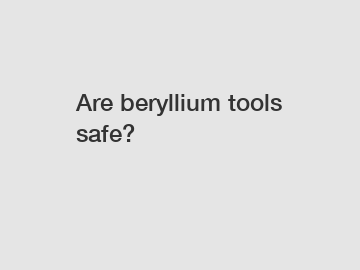Are beryllium tools safe?
Are beryllium tools safe?
Beryllium is a highly versatile and valuable element commonly used in various industries for its superior strength and heat resistance properties. But as with any material, concerns about its safety and potential health hazards arise. In this article, we will delve into the topic of beryllium tools and explore whether they are truly safe to use.
1. Understanding Beryllium:

Beryllium is a lightweight, silver-gray metal primarily found in minerals such as beryl and bertrandite. Due to its excellent thermal conductivity and high resistance to corrosion, it is widely utilized in the aerospace, electronics, and defense industries. Beryllium alloys are known for their remarkable strength-to-weight ratio, making them ideal for applications that require sturdy and durable materials.
2. The Health Risks Associated with Beryllium:
While beryllium offers valuable properties for industrial applications, it can also pose health risks, primarily in its dust or fume form. Inhalation of beryllium particles can lead to a severe and incurable lung disease called chronic beryllium disease (CBD). CBD can manifest in different forms, from acute beryllium disease to chronic lung inflammation.
3. Occupational Exposure and Safety Measures:
Given the potential hazards, it is crucial to ensure proper handling and safety precautions are taken when using beryllium tools. Occupational exposure to beryllium occurs mainly in industries involved in machining, manufacturing, and refining. The Occupational Safety and Health Administration (OSHA) has set strict standards to limit workers' exposure to airborne beryllium, necessitating engineering controls, protective gear, and air monitoring.
4. Beryllium Tools and Safety Protocols:
When it comes to beryllium tools, the risk of exposure to beryllium primarily lies in two scenarios – during the production of beryllium-containing materials and during the use of beryllium-based tools. Manufacturers must adhere to stringent safety protocols to minimize the release of beryllium particles during fabrication. Additionally, workers using beryllium tools must follow appropriate safety measures such as wearing personal protective equipment (PPE) and using local exhaust ventilation to minimize exposure risks.
5. Limiting Public Exposure:
While occupational exposure is often the primary concern, public exposure should not be overlooked. Beryllium can also be released during the disposal of beryllium-containing products or through accidental releases. Proper waste management and adherence to environmental guidelines are necessary to prevent environmental contamination and potential public exposure.
6. Regulatory Standards and Continuous Monitoring:
To ensure the safety of workers and the general public, regulatory bodies impose strict guidelines and limitations on beryllium exposure. Regular monitoring of air quality and environmental samples helps detect and prevent any excessive beryllium release. Moreover, ongoing research and scientific studies contribute to a better understanding of the risks associated with beryllium.
7. Alternatives and Risk Mitigation:
Many industries have explored alternatives to beryllium tools to mitigate potential health risks. Advanced materials such as composites, ceramics, and other alloys can often provide comparable strength and heat-resistance properties without the hazards associated with beryllium. Although these alternatives may not always match beryllium's precise characteristics, they can offer a safer working environment.
Conclusion:
In conclusion, while beryllium tools offer significant benefits in terms of strength and heat resistance, precautions must be taken to ensure the safety of workers and the general public. Occupational exposure to beryllium can lead to severe health issues, making safety protocols and thorough risk assessments crucial. By following stringent safety measures, exploring alternative materials, and staying abreast of regulatory standards, we can strike a balance between utilizing the advantages of beryllium while minimizing its potential risks.
Contact us to discuss your requirements of Brass Tools For Sale, Non-Sparking Cutting Tools, Non Sparking Bars, Punch&Chisel. Our experienced sales team can help you identify the options that best suit your needs.


